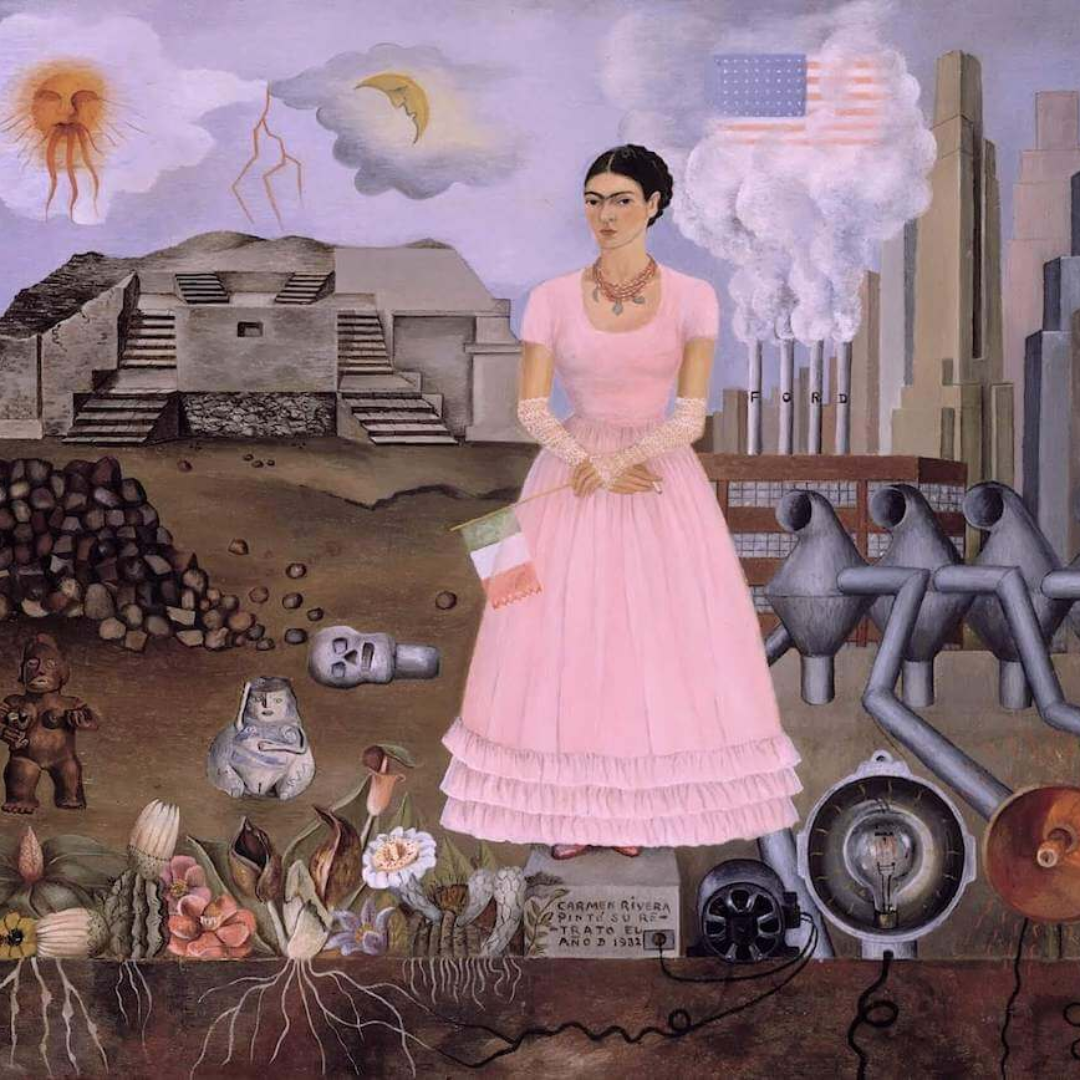Frida Kahlo’s paintings are a vivid tapestry of personal and cultural expression, capturing the depth of her inner life and the rich textures of her Mexican heritage. Known for her striking self-portraits and surrealist style, Kahlo’s work delves into themes of identity, pain, and passion with unparalleled intensity and authenticity. As we explore her iconic paintings, we uncover the layers of emotion and symbolism that make her art timeless and profoundly impactful.
1. The Two Fridas (1939)
The Two Fridas is one of Kahlo’s most celebrated works, offering a profound exploration of her identity and inner conflict. The painting depicts two versions of Frida seated together, one in European attire and the other in traditional Mexican clothing. The two Fridas hold hands, symbolizing a duality in her identity—one that is rooted in her indigenous heritage and the other in her European ancestry. The exposed hearts and the blood connecting them reflect her personal struggles and the fragmentation of her self-image.
2. Self-Portrait with Thorn Necklace and Hummingbird (1940)
In Self-Portrait with Thorn Necklace and Hummingbird, Kahlo portrays herself adorned with a necklace of thorns, which digs into her skin and evokes a sense of suffering. A black hummingbird hangs from the necklace, symbolizing both life and death. The lush, tropical background contrasts with the pain depicted on her face, highlighting the interplay between her personal torment and her vibrant surroundings. This painting encapsulates Kahlo’s ability to blend pain with beauty, creating a powerful narrative of resilience.
3. The Broken Column (1944)
The Broken Column is a poignant depiction of Kahlo’s physical and emotional pain. The painting features Frida with a fractured, exposed column in place of her torso, symbolizing the ongoing physical suffering she endured due to her many health issues, including a severe bus accident and numerous surgeries. Her face, marked by tears and anguish, conveys the emotional depth of her pain. Despite the heavy symbolism, the painting also reflects her enduring strength and determination.
4. Diego and I (1949)
In Diego and I, Kahlo paints a striking self-portrait that incorporates a depiction of her husband, Diego Rivera, on her forehead. This painting reflects the complex and often turbulent relationship between Kahlo and Rivera. The surreal composition, with Kahlo’s eyes gazing upwards and Rivera’s face positioned prominently on her brow, underscores the interconnection between their personal lives and artistic identities. The vibrant colors and intricate details highlight Kahlo’s deep emotional connection to Rivera, despite their turbulent marriage.
5. The Wounded Deer (1946)
The Wounded Deer portrays Kahlo as a stag with multiple arrows embedded in her body, symbolizing her emotional and physical pain. The tranquil forest setting contrasts sharply with the violence inflicted upon the deer, reflecting the dissonance between her external calm and internal suffering. This painting illustrates Kahlo’s use of symbolism to convey the impact of her trauma and her resilience in the face of adversity.
6. Henry Ford Hospital (1932)
In Henry Ford Hospital, Kahlo captures the raw emotion of her experience with a miscarriage she suffered while living in Detroit. The painting depicts Frida lying in a hospital bed, surrounded by various symbols of her loss and despair, including a tiny fetus and a bleeding reproductive system. The painting’s surreal quality and vivid imagery convey the profound grief and physical pain she endured, making it a deeply personal and evocative work.
7. What the Water Gave Me (1938)
What the Water Gave Me is a surrealist exploration of memory and identity. The painting’s composition features a fragmented reflection of Kahlo’s experiences, including elements of her life and personal struggles. The water serves as a metaphor for both the fluidity of memory and the depths of her emotions. The painting’s dreamlike quality and symbolic imagery offer a glimpse into Kahlo’s complex inner world.
8. My Dress Hangs There (1933)
My Dress Hangs There reflects Kahlo’s critique of the commercialism and cultural erosion she observed during her time in the United States. The painting depicts a traditional Mexican dress hanging in a barren landscape, surrounded by symbols of industrialization and consumerism. Kahlo’s use of vivid colors and striking contrasts emphasizes her deep connection to Mexican culture and her discontent with the loss of cultural authenticity.
9. Self-Portrait with Cropped Hair (1940)
Self-Portrait with Cropped Hair is a bold and defiant statement by Kahlo. After her separation from Diego Rivera, she cut her hair short, which she portrays in this self-portrait. The painting features Frida in a masculine suit with her shorn hair scattered around her, symbolizing her rebellion against traditional gender roles and her assertion of personal autonomy. The vibrant colors and direct gaze reflect her strength and individuality.
10. The Love Embrace of the Universe, the Earth (Mexico), Myself, Diego, and Señor Xolotl (1949)
In this expansive and colorful painting, Kahlo presents a cosmic and intimate vision of her world. The work features her, Diego Rivera, and their pet dog, Señor Xolotl, enveloped in a cosmic embrace that symbolizes their profound connection to the universe and each other. The painting’s vibrant colors and intricate details convey a sense of unity and harmony, reflecting Kahlo’s complex relationship with her environment and loved ones.
